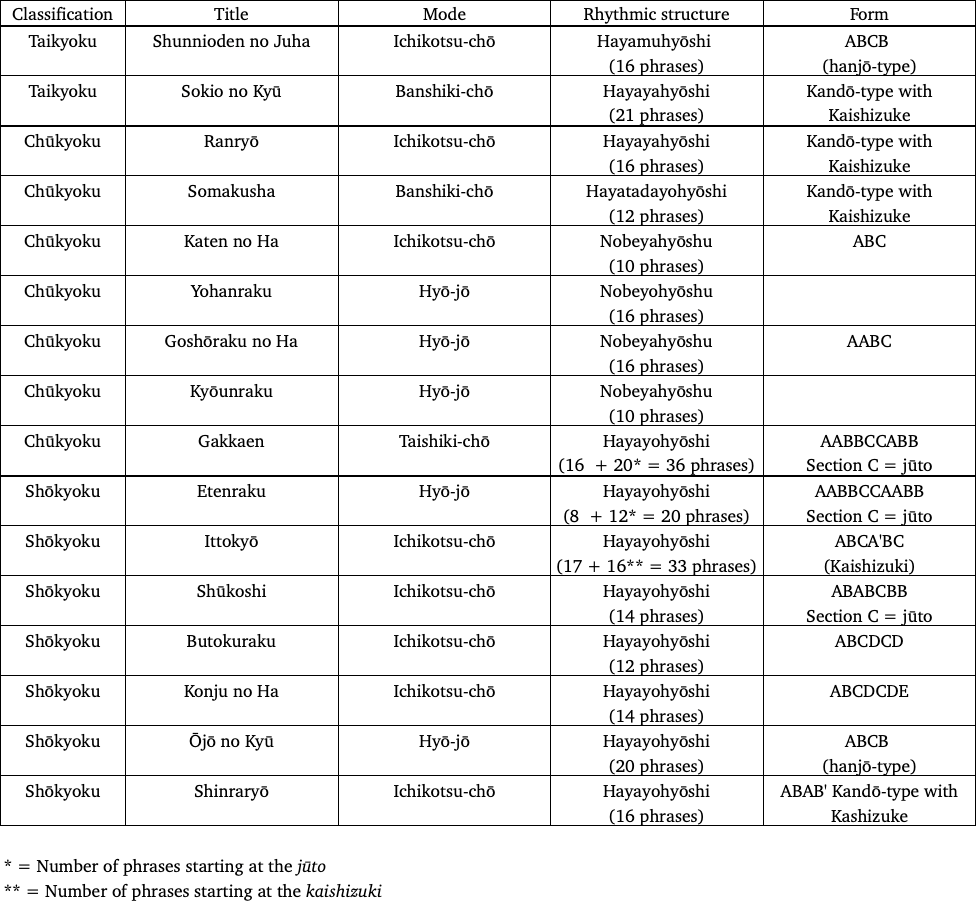Jo-ha-kyū
Jo-ha-kyū is a primary and ubiquitous principle of form in Japanese traditional arts. It is used to describe musical development on all formal levels. It can govern everything from the structure of a musical program, the form of a piece, and the development of a section, to a musical phrase or even an individual note. It is translated as: jo = slow introduction, ha = faster build-up and kyū = fast conclusion. It is traditionally understood as a constant but extremely gradual, sometimes barely perceptible, acceleration of the music. On the highest level of form (program, piece, and section), different sections maybe clearly delineated as representing one of the three parts, but when applied at lower levels (phrase, note) the principle becomes more vague and implies mostly a slow change of tempo and the constant transformation from relatively formless introduction, through more defined development, to a fast rushing, into a breakup.
Programs are often grouped according to the following 4-piece pattern:
- Netori : A piece in free rhythm where only the first chairs and the kakko play. Its function is to establish the mood of the mode. The entrance of the instruments is prescribed : Shō → hichiriki → ryūteki → kakko → biwa → koto
- Jo: A movement also in free rhythm, but it differing from the netori because all instruments participate. Being a movement rather than an introduction, it lasts longer.
- Ha: Usually in nobebyōshi (phrase of 8 measures), this structure contains half of the number of obachi compared to the hayabyōshi structure (phrase of 4 measures). This is significant because obachi is the point of synchronization for the three percussion instruments, and a reference point for timbral changes. With fewer points of synchronization, the nobebyōshi has a slower rhythm of timbral transformation.
- Kyū: Usually in hayabyōshi (phrase of 4 measures), this structure contains twice the number of obachi compared to the nobebyōshi structure (phrase of 8 measures). With the increase in the number of points of synchronization, the hayabyōshi has a faster rate of timbral transformation.
Timbral structure of ha and kyū
- Ōndo: Both sections open with a solo phrase by the ryūteki, called ōndo. They are followed by the entrance of the percussion instruments.
- Tsuku-dokoro: The entrance of the remaining two solo woodwind instruments at or around the strong taiko's stroke is called tsuku-dokoro. This is followed in increments of 2 measures by the first biwa, first koto, second biwa, and finally second koto.
- Tomede: This is a coda where only the first chairs play in free-rhythm and at a slower tempo. The order of the exiting instruments is prescribed: First the Woodwind followed Percussion instruments, then the biwa, and finally the koto.
- Kuwae: Shortly before the tomede, the percussion pattern is accelerated to twice its original speed. For example, a percussion instruments’ pattern of four measures, is accelerated to two measures. Typically, the beginning of the kuwae comes with a noticeable change in the melody. Example 1 and 2 show one of the most common rhythmic patterns of a four measures of four beats, hayayohyōshi and its kuwae.
 Hayayohyōshi
Hayayohyōshi
Example 1
 Kuwae
Kuwae
Example 2
Formal designs
-
Nokori-gaku: A form used when a piece is played 3 times:
- 1st time: Standard with all the instruments
- 2nd time: No percussion instruments, and only the first chairs perform.
- 3rd time: Limited to the first chairs from the Hichiriki, biwa, and koto.
- Jutō: A phrase that serves as transitional material leading back to a repetition of previously presented phrases like the Section C in Etenraku: AABBCCAABB
- Hanjō: Half-point period, i.e. half-point of the piece. Pieces that use this structure are often subdivided into: AB| CB, where B marks the half-point of the first and second sections, and C points to the half-point of the piece.
-
Kandō
- This is an added phrase before the beginning of a repetition:
- ||: …………………………………….end || kando…….. :||
-
Kaishizuke
- This Indicates the returning point for piece whose repetition is not starting from the beginning:
- ||……..…||: Kaishizuke………………………………….. :||
Classification
Tōgaku (encompasses kangen and bugaku) is divided into two categories: kogaku, meaning 'old music,' and it accounts for less than one third of the repertoire, while shingaku, which means 'new music,' encompasses more than two thirds of the repertoire.
Other classifications are based on the length of the piece:
- Taikyoku: Very rarely performed great pieces comprising about 8 movements. Only the very last piece of the cycle concludes on the tonic, all the others conclude on scale degree 3. Moreover, the elaborated coda (tomede) is only played at the end of the last piece, and all the others close with the fuki-nagashi, a technique where the wind players hold their last pitch at full volume for the entire duration before letting the volume to attenuate.
- Chūkyoku: Middle pieces of around two longer movements. Typically, phrases begin on beat 3 in measures of 4 beats, or on beat 5 for measures of 8 beats.
- Shōkyoku: Small pieces of around two shorter movements, typically phrases begin on the 1st beat of the measure.
 Classification of a selection of typical pieces
Classification of a selection of typical pieces
Figure 1